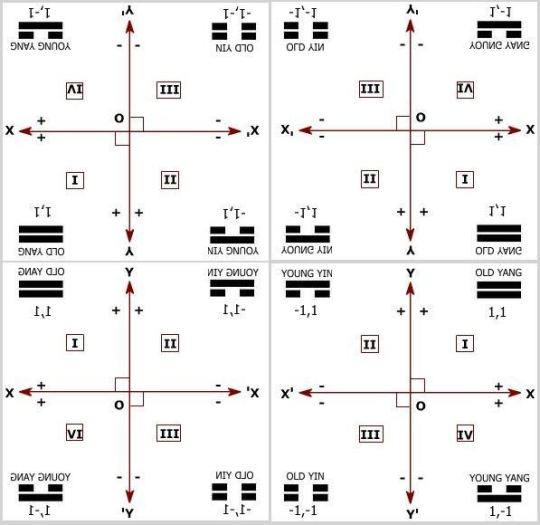#recursion
Beyond the Enlightenment Rationalists:
From imaginary to probable numbers - VI

(continued from here)
“O Oysters, come and walk with us!” The Walrus did beseech. “A pleasant walk, a pleasant talk, Along the briny beach: We cannot do with more than four, To give a hand to each.”
* * *
“The time has come,” the Walrus said, “To talk of many things: Of shoes–and ships–and sealing-wax– Of cabbages–and kings– And why the sea is boiling hot– And whether pigs have wings.”
-Lewis Carroll, The Walrus and the Carpenter

In this segment, probable numbers will be shown to grow out of a natural context inherently rather than through geometric second thought as transpired in the history of Western thought with imaginary numbers and complex plane. To continue with development of probable numbers it will be necessary to leave behind, for the time being, all preoccupation with imaginary numbers and complex plane. It will also be necessary to depart from our comfort zone of Cartesian spatial coordinate axioms and orientation.
Probable coordinates do not negate validity of Cartesian coordinates but they do relegate them to the status of a special case. In the probable coordinate system the three-dimensional coordinate system of Descartes maps only one eighth of the totality. This means then, that the Cartesian two-dimensional coordinate plane furnishes just one quarter of the total number of corresponding probable coordinate mappings projected to a two-dimensional space.[1] It suggests also that Cartesian localization in 2-space or 3-space is just a small part of the whole story regarding actual spatial and temporal locality and their accompanying physical capacities, say for instance of momentum or mass, but actually encompassing a host of other competencies as well.
Although this might seem strange it is a good thing. Why is it a good thing? First, because nature, as a self-sustaining reality, cannot favor any one coordinate scheme but must encompass all possible - if it is to realize any. Second, because both the Schrödinger equationandFeynman path integral approaches to quantum mechanics say it is so.[2] Third, because Hilbert space demands it. This may leave us disoriented and bewildered, but nature revels in this plan of probable planes. Who are we to argue?
So how do we accomplish this feat? Well, basically by reflections in all dimensions and directions. We extend the Cartesian vectors every way possible. That would give us a 3 x 3 grid or lattice of coordinate systems (the original Cartesian system and eight new grid elements surrounding it), but there are only four different types, so we require only four of the nine to demonstrate. It is best not to show all nine in any case because to do so would place our Cartesian system at direct center of this geometric probable universe and that would be misleading. Why? Because when we tile the two-dimensional universe to infinity in all directions, there is no central coordinate system. Any one of the four could be considered at the center, so none actually is. Overall orientation is nondiscriminative.[3]

LOOKING GLASS CARTESIAN COORDINATE QUARTET
The image seen immediately above shows four Looking House Cartesian coordinate systems, correlated within a mandalic plane. This mandalic plane is one of six faces of a mandalic cube, each of which is constructed to a different plan but composed of similar building blocks, the four bigrams in various positions and orientations. A 2-dimensional geometric universe can be tiled with this image, recursively repeating it in all directions throughout the two dimensions.[4] It should not be very difficult for the reader to determine which of the four mandalic moieties references our particular conventional Cartesian geometric universe.[5]

It remains only to be added here and now that potential dimensions, probable planes, and probable numbers arise immediately and directly from the remarks above. In some ways it’s a little like valence in chemical reactions. We’ll likely take a look at that combinatory dynamic in context of mandalic geometry at some time down the road. Next though we want to see how the addition of composite dimension impacts and modifies the basic geometry of the probable plane discussed here.[6]
(to be continued)
Top image: The four quadrants of the Cartesian plane. These are numbered in the counterclockwise direction by convention. Architectonically, two number lines are placed together, one going left-right and the other going up-down to provide context for the two-dimensional plane. This image has been modified from one found here.
Notes
[1] To clarify further: There are eight possible Cartesian-like orientation variants in mandalic space arranged around a single point at which they are all tangent to one another. If we consider just the planar aspects of mandalic space, there are four possible Cartesian-like orientation variants which are organized about a central shared point in a manner similar to how quadrants are symmetrically arranged about the Cartesian origin point (0,0) in ordinary 2D space. But here the center point determining symmetries is always one of the points showing greatest rather than least differentiation. That is to say it is formed by Cartesian vertices, ordered pairs having all 1s, no zeros. That may have confused more than clarified, but it seemed important to say. We will be expanding on these thoughts in posts to come. Don’t despair. For just now the important takeaway is that the mandalic coordinate system combines two very important elements that optimize it for quantum application: it manages to be both probabilistic and convention-free (in terms of spatial orientation, which surely must relate to quantum states and numbers in some as yet undetermined manner.) At the same time, imaginary numbers and complex plane are neither.
[2] Even if physics doesn’t yet (circa 2016) realize this to be true.
[3] It is an easy enough matter to extrapolate this mentally to encompass the Cartesian three-dimensional coordinate system but somewhat difficult to demonstrate in two dimensions. So we’ll persevere with a two-dimensional exposition for the time being. It only needs to be clarified here that the three-dimensional realization involves a 3 x 3 x 3 grid but requires just eight cubes to demonstrate because there are only eight different coordinate system types.
[4] I am speaking here in terms of ordinary dimensions but it should be understood that the reality is that the mandalic plane is a composite 4D/2D geometric structure, and the mandalic cube is a composite 6D/3D structure. The image seen here does not fully clarify that because it does not yet take into account composite dimension nor place the bigrams in holistic context within tetragrams and hexagrams. All that is still to come. Greater context will make clear how composite dimension works and why it makes eminent good sense for a self-organizing universe to invoke it. Hint: it has to do with quantum interference phenomena and is what makes all process possible.
ADDENDUM (12 APRIL, 2016)
The mandalic plane I am referring to here corresponds to the Cartesian 2-dimensional plane and is based on four extraordinary dimensions that are composited to the ordinary two dimensions, hence hybrid 4D/2D. It should be understood though that any number of extra dimensions could potentially be composited to two or three ordinary dimensions. The probable plane described in this post is not such a mandalic plane as no compositing of dimensions has yet been performed. What is illustrated here is an ordinary 2-dimensional plane that has undergone reflections in x- and y-dimensions of first and second order to form a noncomposited probable plane. The distinction is an important one.
[5] This is perhaps a good place to mention that the six planar faces of the mandalic cube fit together seamlessly in 3-space, all mediated by the common shared central point, in Cartesian terms the origin at ordered triad (0.0.0) where eight hexagrams coexist in mandalic space. Moreover the six planes fit together mutually by means of a nuclear particle-and-force equivalent of the mortise and tenon joint but in six dimensions rather than two or three, and both positive and negative directions for each.
[6] It should also be avowed that tessellation of a geometric universe with a nondiscriminative, convention-free coordinate system need not exclude use of Cartesian coordinates entirely in all contextual usages. Where useful they can still be applied in combination with mandalic coordinates since the two can be made commensurate, irrespective of specific Cartesian coordinate orientation locally operative. Whatever the Cartesian orientation might be it can always be overlaid with our conventional version of the same. More concretely, hexagram Lines can be annotated with an ordinal numerical subscript specifying Cartesian location in terms of our local convention should it prove necessary or desirable to do so for whatever reason.
On the other hand, before prematurely throwing out the baby with the bath water, we might do well to ask ourselves whether these strange juxtapositions of coordinates might not in fact encode the long sought-after hidden variables that could transform quantum mechanics into a complete theory. In mandalic coordinates of the reflexive nature described, these so-called hidden variables could be hiding in plain sight. Were that to prove the case, David Bohm andLouis de Broglie would be immediately and hugely vindicated in advancing their pilot-wave theory of quantum mechanics. We could finally consign the Copenhagen Interpretation to the scrapheap where it belongs, along with both imaginary numbers and the complex plane.
ADDENDUM (24 APRIL, 2016)
Since writing this I’ve learned that de Broglie disavowed Bohm’s pilot wave theory upon learning of it in 1952. Bohm had derived his interpretation of QM from de Broglie’s original interpretation but de Broglie himself subsequently converted to Niels Bohr’s prevailing Copenhagen interpretation.
© 2016 Martin Hauser
Please note: The content and/or format of this post may not be in finalized form. Reblog as a TEXT post will contain this caveat alerting readers to refer to the current version in the source blog. A LINK post will itself do the same. :)
Scroll to bottom for links to Previous / Next pages (if existent). This blog builds on what came before so the best way to follow it is chronologically. Tumblr doesn’t make that easy to do. Since the most recent page is reckoned as Page 1 the number of the actual Page 1 continually changes as new posts are added. To determine the number currently needed to locate Page 1 go to the most recent post which is here. The current total number of pages in the blog will be found at the bottom. The true Page 1 can be reached by changing the web address mandalicgeometry.tumblr.com to mandalicgeometry.tumblr.com/page/x, exchanging my current page number for x and entering. To find a different true page(p) subtract p from x+1 to get the number(n) to use. Place n in the URL instead of x (mandalicgeometry.tumblr.com/page/n) where
n = x + 1 - p. :)
-Page 311-
Recursion
by Blake Crouch
Could Blake Crouch please write more books so I can start a novel and then read until the wee hours of the morning every single night of my life?
For some reason, I keep on thinking, If Blake Crouch told me to jump off a bridge, I just might. Though it’d have nothing to do with peer pressure. I think I’d step off that bridge just because I wouldn’t be surprised if his concept of time, space and reality so far transcends mine that that small time continuum disturbance would save the world in some way.
Crouch is simply a master sci-fi storyteller. Do you love slightly alternative worlds to ours? Check. Love near-plausible catastrophic worldwide scenarios? Check. Love books that blow your mind with their theories? Check.
Recursion starts with a world that is suffering from False Memory Syndrome, a seemingly isolated disease in which people experience “false memories” of a life they never lived while simultaneously living the life they do. This naturally causes many a psychotic break. Because what if you remembered a world where you had a spouse and child and rewarding job and suddenly find yourself single, childless and bankrupt?
I almost don’t know how to write about Recursion because there comes a time while reading Crouch’s books where my meager astrophysical understanding of the world collides with reality to create a fissure through which I can peek into a distinct possibility that he is not the storyteller of a fictional tale, but rather a harbinger of a real impending doom.
I read Dark Matter in one sitting. I opened it at bedtime. I turned the last page before I fell asleep. Recursion I savored over the course of a 24-hour period, though from self-control or fear for our precarious world, I cannot say which.
In some way, Blake Crouch writes the stuff of nightmares: science, power, playing God. The problem is: sometimes it’s hard to tell whether or not we’re awake.
Post link
We were really excited to get a chance to talk with Dr. Tecumseh Fitch! Dr. Fitch is an evolutionary biologist and cognitive scientist who received his PhD from Brown University, and is now a professor in the Department of Cognitive Biology at the University of Vienna. He’s published extensively on the evolution of speech, language, and music, and is the author of the 2010 book The Evolution of Language.
In our interview, we discussed the following topics:
- his recent research on whether it’s anatomy or neurology holding back monkeys from speech
- his thoughts on Darwin’s hypotheses about how language may have evolved
- how to come up with good hypotheses about how language evolved, given that it doesn’t leave fossils
- what he believes is different about humans that led to the development of language
… and more! Thanks to Dr. Fitch for talking with us. Looking forward to hearing what people have to say!
“Life with a cheat code isn’t life. Our existence isn’t something to be engineered or optimized for the avoidance of pain. That’s what it is to be human-the beauty and the pain, each meaningless without the other.”
Barry Sutton, Recursion
“There are so few things in our existence we can count on to give us the sense of permanence, of the ground beneath our feet. People fail us. Our bodies fail us. We fail ourselves. But what do you cling to, moment to moment, if memories can simply change. What, then, is real? And if the answer is nothing, where does that leave us?”
Barry Sutton, Recursion
Anna Ewers in Raf Simons spring\summer 2017 with Robert Mapplethorpe photographs of Carol Overby (1979) on shirt for I-D magazine.
Photographed by Mario Sorrenti
Post link
Recursive Yearning Meme!





